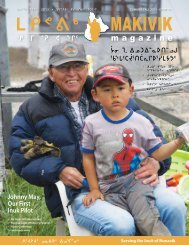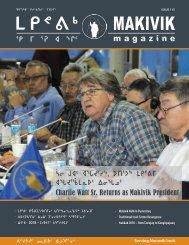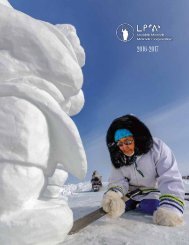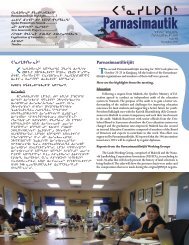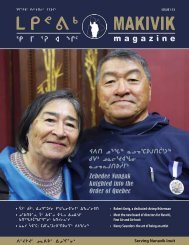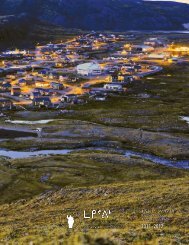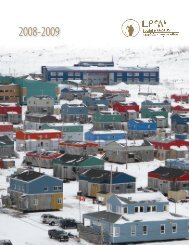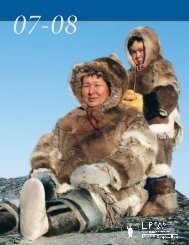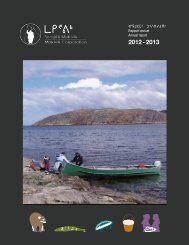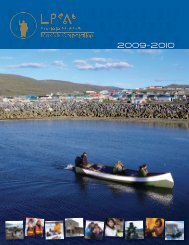Makivik Magazine Issue 102
Create successful ePaper yourself
Turn your PDF publications into a flip-book with our unique Google optimized e-Paper software.
ck9l xtQ4 yo8ic3m¯5 h3çtEJ6 xg3hi h3çtDt9lf xWo xamJu4.<br />
Measuring the diameter with a special tape.<br />
Kuujjuaraapik Students,<br />
Science with the Centre<br />
d’études nordiques (CEN)<br />
and Youth Fusion<br />
By Alexandre Truchon-Savard<br />
On June 15, 2013 eight of Kuujjuaraapik’s Asimauttaq<br />
students were eagerly loading tents, sleeping bags, air<br />
mattresses, stoves and coolers on the flatbed of the<br />
CEN’s truck. Along with the camping gear were GPS’s,<br />
Presler tree corers, compasses, cameras, diameter tapes,<br />
and notepads.<br />
Thanks to a partnership between Youth Fusion, the<br />
Laval University’s Centre d’études nordiques (Centre<br />
for Northern Studies) and Asimauttaq School, the class<br />
studied dendro-ecology — the science of trees and<br />
their environment — and tried out field sampling techniques,<br />
while spending time on the land, and enjoying<br />
an overnight field trip with their friends. Youth Fusion is<br />
a charitable organization that aims to engage youth in<br />
learning and to develop activities that motivate them<br />
to stay in school.<br />
For some students, it was the first time camping,<br />
but for all it was their first time measuring the age<br />
of a tree. Teachers Geneviève-Clhéo Hotte-Vaudry<br />
and Darren Luck, Youth Fusion science coordinator<br />
Alexandre Truchon-Savard, and biology technician<br />
Geneviève Degré-Timmons accompanied the group.<br />
At the campsite everyone helped to set up the tents<br />
and prepare a quick lunch. Then they hiked through<br />
the hills following GPS coordinates. After a few kilometres,<br />
they paused to observe the willows and flowers growing on the hilltops. Walking<br />
through a tamarack forest, the students noticed the difference in the soil’s moisture.<br />
Finally the party reaches its destination: a mature spruce stand. The team set up a<br />
100-m 2 plot. Each living tree was cored, which means drilling a small hole and extracting<br />
a sample of the tree where the growth rings can be counted and measured. The<br />
students then measured the diameter of each mature tree and the height of the saplings.<br />
Lastly, four sub-plots of 400 cm 2 were used to estimate the ground cover of the<br />
forest plants. After carefully recording all the data in notebooks, it was time to find the<br />
way back to camp using the GPS.<br />
Back at camp, everyone gathered to play a game of capture-the-flag on the sand<br />
dunes, prepare dinner and head to Second Point. The sunset over Hudson Bay was gorgeous,<br />
but the cold air called for a bonfire. Around the fire, the group debriefed about<br />
the day’s experience, told stories and did some stargazing. “That was my favourite part!”<br />
said Yasmine, one of the youth.<br />
The following morning, the group packed up the campsite and headed back to the<br />
village. After the tree samples were dried and finely sanded, it was possible to count<br />
the rings to discover the age of the trees. Although the trees are only 12.6 cm in diameter,<br />
their average age is 141 years old!<br />
Science project coordinator Truchon-Savard, who completed<br />
his master’s research in ecology at the CEN, explained to the<br />
students that the relationship between the age of these trees<br />
and their size can be expressed using a simple equation: tree<br />
diameter = 0.15 x (age) — 8.8.<br />
Each year, the CEN welcomes hundreds of scientists and<br />
science students, specializing in biology, ecology, geology,<br />
microbiology and environmental science. Youth Fusion’s Science<br />
project coordinator builds bridges between this scientific community<br />
and the two local schools.<br />
Through these activities, students discover science careers<br />
and the hands-on, real-world science that is going on right in<br />
their own community. These activities are possible thanks to the<br />
support of Ungaluk and the Rogers Youth Fund.<br />
WZh5g6 NÙ3©2 wrxzi4.<br />
Collecting a tree core.<br />
Throughout the school year, Truchon-Savard works at the schools<br />
on a daily basis, planning and leading hands-on science activities,<br />
both inside and outside the classroom. Youth are also invited<br />
to visit the CEN’s Community Science Centre and weather station.<br />
MAKIVIK mag a zine<br />
75






